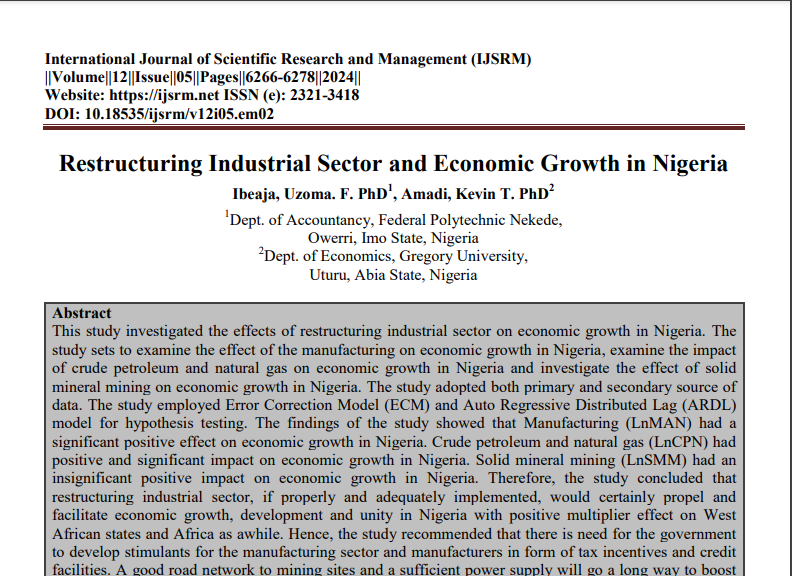
Submission to VIJ 2024-05-06
Copyright (c) 2024 Ibeaja F. Uzoma, Amadi Kevin T.

This work is licensed under a Creative Commons Attribution 4.0 International License.
Abstract
This study investigated the effects of restructuring industrial sector on economic growth in Nigeria. The study sets to examine the effect of the manufacturing on economic growth in Nigeria, examine the impact of crude petroleum and natural gas on economic growth in Nigeria and investigate the effect of solid mineral mining on economic growth in Nigeria. The study adopted both primary and secondary source of data. The study employed Error Correction Model (ECM) and Auto Regressive Distributed Lag (ARDL) model for hypothesis testing. The findings of the study showed that Manufacturing (LnMAN) had a significant positive effect on economic growth in Nigeria. Crude petroleum and natural gas (LnCPN) had positive and significant impact on economic growth in Nigeria. Solid mineral mining (LnSMM) had an insignificant positive impact on economic growth in Nigeria. Therefore, the study concluded that restructuring industrial sector, if properly and adequately implemented, would certainly propel and facilitate economic growth, development and unity in Nigeria with positive multiplier effect on West African states and Africa as a whole. Hence, recommended that there is need for the government to develop stimulants for the manufacturing sector and manufacturers in form of tax incentives and credit facilities. A good road network to mining sites and a sufficient power supply will go a long way to boost the productivity of the sector. Government should encourage the production of more agricultural products that could be used as raw materials by manufacturing industries to achieve balanced growth between the agricultural and the manufacturing industries of the Nigerian economy.
References
- Abdu, M. & Anam, B. E. (2018), Evaluation of the Nigerian industrial sector and economic growth in the face of sustainable development goals. International Journal of Advanced Research in Public Policy. Social Development and Enterprise Studies
- Abiodun, M. A. & Ochuwa, P. E. (2020), Response of economic growth to the dynamics of the service sector in Nigeria. Future Business Journal, Vol.6 (27)
- Adeusi, S.O. & Aluko, O.A. (2015), Relevance of financial sector development on real sector productivity: 21st century evidence from Nigerian industrial sector. International Journal of Academic Research in Business and Social Sciences, 5(6), 118-132.
- Afolabi, B. and Ogoh, S (2017), Industrial output and economic growth in Nigeria. European Journal of Scientific Research
- Agba, P.U and R.O Dum (2016), Development economics. Kricel publishers, Owerri, Imo State.
- Ahuja M. (2021), Personal savings in developing nations. Journal of Economic Record, World bank
- Amadi. K.T (2023), Microfinance banks and growth of agricultural sector in Nigeria. International Journal of Agriculture, Management and Technology, Vol. 5 www.ijamt.com
- Ani, G. A., and Udeh, S. N (2021), Exchange rate and economic growth in Nigeria. Advance Journal of Management and Social Sciences, Vol. 5(5)
- Anyanwu, A. V. (2016), Research methodology in business and social sciences (Second Edition). Avan Global publishers, Owerri, Nigeria
- Akinmulegun, S. O. and Falana, O. E (2018), Exchange rate fluctuation and industrial output growth in Nigeria. International Journal of Economics and Financial Research, 4(5):145-158
- Ajayi, O. (2021). Nigeria’s manufacturing sector contracted by 2.75% in 2020. Naira metric.
- Ajie, C.O; Okoh, S.O; & Ojiya, E.A. (2019), The imapct of solid minerals resources on economic Growth of Nigeria: An OLS and Causality Approach. International Journal of Humanities, Art and Social Studies (IJHAS), Vol. 4(1)
- Breusch, T. S (1978), Testing for autocorrelation in dynamic linear models. Australian Economic Papers. 17: 334–355
- Chete, L. N.; Adeoti, J. O.; Adeyinya, F. M. and Ogundele, O. (2016), Industrial development and growth in Nigeria: Lessons and Challenges. Nigerian Institute of Social and Economic Research (NISER), Ibadan. Working Paper 8
- Dickey, D. A. & Fuller, W. A. (1979), Distribution of the estimators for autoregressive time series with a unit root. Journal of the American Statistical Association, 74, pp.427-431
- Dutshime, A. and Osele, A. (2021), Nigeria: An overview of the economic impact of the coronavirus pandemic in Nigeria. KPMG, Nigeria
- Ediri, E. (2021), Power generation: Nigeria’s Average Unutilized Power Rises 291% to 3,008.1MW in 8 Years. Vanguard News 30th November 2021.
- Godfrey, L. G. (1978), Testing against general autoregressive and moving average error models when the regressors include lagged dependent variables. Econometrica. 46: 1293–1301.
- Jelilov, G., Enwerem, H. I. and Isik, A. (2016), The impact of industrialization on economic growth: The Nigerian experience (2000-2013). British Journal of Advance Academic Research 5(1),11-20.
- Jinghan, M. L. (2011), The economics of development and planning. 40th Edition Vrinda Publications Limited BS, Ashish Complex, Mayur Vihar Phase I, Delhii 110091
- KPMG Report (2020), Covid-19: A business impact series: Financial, Tax and Regulatory Considerations to Manage Covid-19 Disruptions, issue 2 April 2020
- Konyeaso, F.U., (2016), Impact of globalization on Nigeria's economy. Pyrex journal of business and finance management research. Vol 2 (10),109-121
- Loto, M. A. and Musa, S. O. (2018), Effect of macroeconomic policy on industrial sector performance in Nigeria (1981-2016). Journal of Sustainable Development in Africa, 20(4): 37-64
- Misra, S. K., and Puri, V. K. (2010), Economics of development and planning — Theory and Practice (12th ed.). Himalaya Publishing House. 217–222
- Nath, S. K. (1962), The theory of balanced growth. Oxford Economic Papers, Vol.14, No. 2, Oxford University Press: 138-153